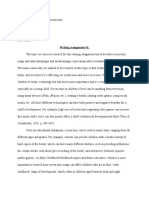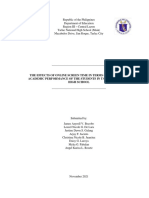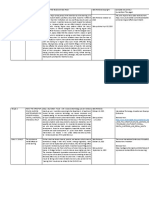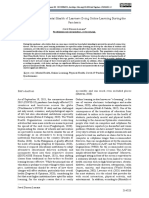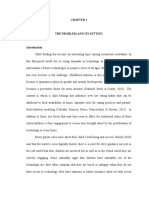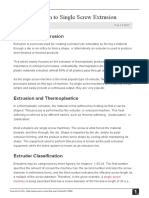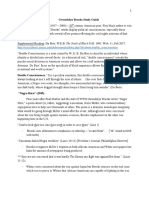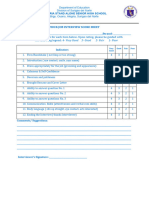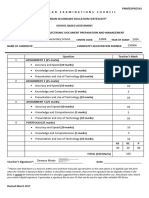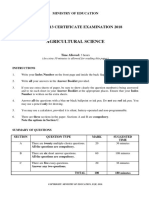Screen Time
Children have been spending much more time in front of the screen, particularly when they have
been undergoing the COVID-19 pandemic, and its effects have resulted in a more persistent
reliance caused by the use of digital devices in acquiring education and then entertainment
(Nagata et al., 2020). Although technology may assist in learning, the long-term effect of using
screens has been associated with adverse health behaviors, including poor sleeping patterns, eye
fatigue, and psychological disorders (Sultana et al., 2021). Moreover, excessive screen time has
been demonstrated to favor a lack of exercise, which indirectly causes obesity and other health
issues (Xiang et al., 2020). The inability to concentrate was reported by many learners during
online studying, and the more schoolchildren spent their time in front of the screen, the more
attention issues and exhaustion they dealt with (Dangi & George, 2021). In addition to that,
longer screen time was correlated with social isolation and the lack of contact with peers, which
impacted the emotional development of children (Pujol et al., 2021). Notably, considerations
focus on the necessity of a balanced use of screens, the relevance of parental supervision and
regularly planned breaks to reduce the harmful outcomes (Ravens-Sieberer et al., 2021).
Academic Productivity
In the last several years, screen time patterns affected academic productivity, that is the
efficiency of students in learning activities and accomplishing academic objectives (Dong et al.,
2020). Limited learning and poor academic success in school-going children has been found to
be related to excessive use of screens that are not related to education (Alonso et al., 2021). It has
been demonstrated that spending much time in connection with entertainment media affects the
activities and progress of learners because it means looking less and working more (Domingues-
Montanari, 2021). Furthermore, sleep pattern interruptions because of screen use at night may
lead to concentration and memory loss, which also decreases academic effectiveness (Lissak,
2020). Conversely, when learners are engaged in purposeful screen use at moderate amounts and
when it is well supervised and combined with active learning strategies, screen use can become
an entirely academically inclusive experience (Zhao et al., 2021). Nevertheless, lacking the
adequate time management and screen-time control, numerous students do not manage to engage
in both academic and leisure screen to the required extent, which eventually influences their
productivity and academic achievements (Viner et al., 2021).
References
Alonso, C., Fernández, D., & González, M. (2021). The influence of digital device use on
academic performance: Evidence from children. Computers & Education, 172, 104262.
https://doi.org/10.1016/j.compedu.2021.104262
�Dangi, R. R., & George, M. (2021). Psychological perception of students during COVID-19
pandemic in India. Children and Youth Services Review, 127, 106085.
https://doi.org/10.1016/j.childyouth.2021.106085
Domingues-Montanari, S. (2021). Clinical and psychological effects of excessive screen time
on children. Acta Paediatrica, 110(1), 22–26. https://doi.org/10.1111/apa.15282
Dong, C., Cao, S., & Li, H. (2020). Young children’s online learning during COVID-19
pandemic: Chinese parents’ beliefs and attitudes. Children and Youth Services Review, 118,
105440. https://doi.org/10.1016/j.childyouth.2020.105440
Lissak, G. (2020). Adverse physiological and psychological effects of screen time on
children and adolescents: Literature review and case study. Environmental Research, 184,
109209. https://doi.org/10.1016/j.envres.2020.109209
Nagata, J. M., Abdel Magid, H. S., & Pettee Gabriel, K. (2020). Screen time for children and
adolescents during the coronavirus disease 2019 pandemic. Obesity, 28(9), 1582–1583.
https://doi.org/10.1002/oby.22917
Pujol, J., Martinez-Vilavella, G., Macia, D., Fenoll, R., Martinez-Zalacain, I., Morales, M., ...
& Soriano-Mas, C. (2021). Traffic pollution exposure is associated with altered brain
connectivity in school children. NeuroImage, 228, 117712.
https://doi.org/10.1016/j.neuroimage.2020.117712
Ravens-Sieberer, U., Kaman, A., Erhart, M., Devine, J., Schlack, R., & Otto, C. (2021).
Impact of the COVID-19 pandemic on quality of life and mental health in children and
adolescents in Germany. European Child & Adolescent Psychiatry, 30, 1389–1400.
https://doi.org/10.1007/s00787-021-01726-5
Sultana, A., Tasnim, S., Hossain, M. M., Bhattacharya, S., Purohit, N., & Hossain, S. (2021).
Digital screen time during the COVID-19 pandemic: A public health concern. Heliyon,
7(12), e08537. https://doi.org/10.1016/j.heliyon.2021.e08537
Viner, R. M., Russell, S. J., Saulle, R., Croker, H., Stansfield, C., Packer, J., ... & Ward, J.
(2021). School closures during social lockdown and mental health, health behaviors, and
well-being among children and adolescents: A systematic review. JAMA Pediatrics, 175(6),
635–645. https://doi.org/10.1001/jamapediatrics.2021.0180
Xiang, M., Zhang, Z., & Kuwahara, K. (2020). Impact of COVID-19 pandemic on children
and adolescents’ lifestyle behavior larger than expected. Progress in Cardiovascular
Diseases, 63(4), 531–532. https://doi.org/10.1016/j.pcad.2020.04.013
Zhao, Y., Guo, Y., Xiao, Y., Zhu, R., Sun, W., Huang, W., & Wu, Y. (2021). The effects of
online learning on college students in China during the COVID-19 pandemic: An empirical
study. Sustainability, 13(13), 7610. https://doi.org/10.3390/su13137610
�Cronbach
Cronbach alpha was calculated in order to guarantee the reliability of the structured
questionnaire that was used in data collection. Particularly, a single Cronbach alpha was drawn
on each group of questions that estimated screen use and academic productivity respectively.
Each of the scales contained a minimum of 10 items aimed at determining a constant measure
amongst the participants. An acceptable Cronbach alpha value of 0.70 and above is
representative of positive internal consistency of the instrument.
Synthesis
Recent views within the literature on the topic have shown a gradual growth of concern towards
excessive screen time of Grade 6 learners and its impact on academic performance and
developmental well-being between the years 2020 and 2025. Notably, Moubayed et al. (2020)
mention that student engagement, that is, both the emotional, behavioral, and cognitive
participation, is found to be one of the most critical factors of academic performance when it
comes to digital learning. Intrinsic motivation can be observed when students are allowed to
participate in such activities as discussing online, online quizzes, and online learning blogs.
Nonetheless, in case students log onto virtual platforms without a significant level of cognition,
data distortion is registered, which annuls the adequate measurement of their performance.
Similarly, a study by Backlinko (2025) concluded that on a daily basis, children between the age
of 8 and 12 screen time was approximately five hours, with purpose being recreation-related, that
is, play, social media, and video streaming. The proliferation of learning resources on the web
may not necessarily amount to relevant academic consumption and this has raised the fear of
cognitive overload, reduced attention span as well as a low academic productivity. To prove this
point, the data presented by the World Health Organization (2021) show that of 0.5 to 1.5 hours
spent watching the screen, of children aged 10-12, only 0.5 to 1 hour is used to teach, with the
rest of the time left to entertain. All these data point to the necessity of knowledge-driven
�policies and interventions to make sure that screen time is beneficial to intellectual development
and that it does not undermine then.
Kids have been increasingly using screens (and during the COVID-19 pandemic, spent even
more time in front of screens), which has led to a more long-term dependence on digital tools
both in terms of education and entertainment (Nagata et al., 2020). Despite the fact that
technology can promote learning, there is a strong correlation between the long-term
consequences of using a screen and maladaptive health behaviors such as the loss of sleep, eye
strain, and mental illnesses (Sultana et al., 2021). Additionally, hyperpnea has been identified to
cause inactivity which in turn leads to obesity and other health related problems (Xiang et al.,
2020). Due to the experience of not being able to focus in an online classroom, several students
have reported difficulties in attention and fatigue which increase with the length of screen time
(Dangi & George, 2021). Moreover, spending a lot of time in front of screens is linked to poor
emotional growth among children due to a lack of social interaction and being alone (Pujol et al.,
2021). It is worth mentioning, though, that the findings of recent studies show that balanced
screens exposure and parental oversight, as well as planned breaks, help prevent adverse effects
(Ravens-Sieberer et al., 2021).
In addition to its academic impacts, extreme screen-time has adverse cognitive, behavioral, and
emotional impact. American Academy of Pediatrics (2023) confirms that over utilizing digital
devices decreases the quality of interactions between a caregiver and a child that are fundamental
in developing a child into a communicative, empathetic, as well as being able to manage their
emotions. School performance can be poor and functioning as executive may be impaired
because of insufficientness of such skills. The same study by Sidiq et al. (2025) also validated
that a larger percentage of recreation screens among students in Grade 6 in India was associated
with significant reduction in academic ranks even after adjusting body mass index (BMI) and
behavior and level of anxiety. Such a conclusion stresses the significance of introducing screen
management education into the school health and educational programs. Academic productivity
(or the effective students in educational tasks and meeting academic goals) has also affected
screen time patterns directly in the recent years (Dong et al., 2020). Overproduction of non-
�educational screens and lack of learning has always been linked with low academic performance
and poor quality (Alonso et al., 2021). Wasting a lot of time on entertainment media hinders
learning time and concentration, which leads to low progress (Domingues-Montanari, 2021).
Distracted sleep due to using the screen at night also worsens the ability to concentrate and
memorize, which reduces academic productivity (Lissak, 2020). On the other hand, screens may
promote academic energy and efficiency when students adopt appropriate screen time and utilise
it to take part in active learning tactics (Zhao et al., 2021). Nevertheless, the inability to manage
and control their time results in students having difficulties in achieving a balance between
screen activities that pertain to the educational process and their leisure time, eventually affecting
their academic achievements (Viner et al., 2021). Therefore, the coordinated effort of the parents,
teachers, and policy developers is essential in the promotion of purposeful, age-appropriate, and
education-oriented screen time use as an integral part of the prosperity of young students.
















